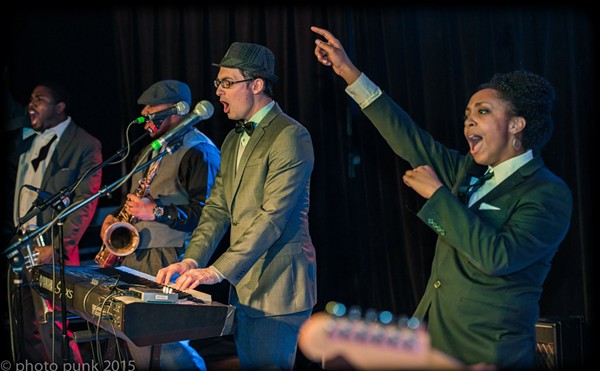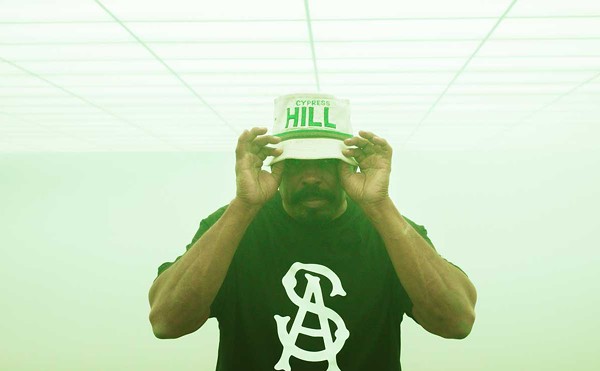As a woodwind virtuoso, he has few peers. His solo saxophone concerts and recordings (a format that Mitchell and fellow-Chicagoan Anthony Braxton pioneered in the late '60s) are truly revelatory explorations of acoustic space.
His deep knowledge of the jazz tradition; his savvy use of reeds, whistles, flutes and "found" percussion instruments, and his technical mastery of circular breathing, multiphonics and overtones combine to create the rich and extensive musical palette he uses to color and shape the surrounding air.
Equally noteworthy is Mitchell's eerily empathic ensemble playing, in which he subtly sustains the music's complex structure by "suggesting" with his horn whatever changes in tonal color, rhythm or intensity will advance and enhance the collective sound.
As a bandleader, Mitchell has convened a succession of cutting-edge ensembles, including his quartet (which became the world-famous Art Ensemble of Chicago); the Roscoe Mitchell Big Band; the critically acclaimed Sound Ensemble, which will join him Sunday; the Space Ensemble, and the Note Factory.
Finally, and perhaps most importantly, there is Roscoe Mitchell the composer, who has devoted more than 30 years to investigating some of the big musical issues of our time. Consider, for example, his magnificent obsession with exploring the ever-shifting borders between "formal" composition and "free" improvisation.
Consider, too, Mitchell's deep meditations on the sonic world and its complex, if companionable, relationship with silence. In Mitchell's compositions, silence is never "outside" the music: It, too, is "sounded" and "heard" as the essential medium or space in which the melody passes through time.
(As David Steindl-Rast observes in his monograph on Gregorian chant, "Music is not merely a rhythmic arrangement of notes, but derives its life from the matrix of silence out of which it arises and into which it inevitably flows.")
If Mitchell's music is demanding at times, it is also consistently rewarding. Though his compositions invite and deserve our active and thoughtful attention, they allow us the very real pleasure of using and expanding our musical imaginations.
Throughout Mitchell's singularly uncompromised career, and as various as his musical projects have been, there is an underlying unity of purpose, a sonic if utopian continuum. To hear this, you need only compare his debut album Sound (Delmark, 1966) and his recently released Sound Songs (Delmark, 1997).
Mitchell's historic first album not only heralded the arrival of an awesome third wave of free-jazz innovators, it also suggested several alternate routes "out" of the cul-de-sac implicit in the "energy music" that preceded it.
Sound demonstrated that renewed attention to musical form, greater variations in texture and dynamics, and more concern for thematic development would be important elements in "the shape of jazz to come." Mitchell's subsequent recordings, and those of his colleagues in the Association for the Advancement of Creative Musicians, provide ample proof that this was more than just a notion.
With Sound Songs (a solo tour de force), we find that the trail Mitchell blazed in his early recordings has led him ever more deeply into the physics of sound and ever further outward toward a vast sonic horizon. Like a Zen master, he has followed his breath to the source of his musical microcosm and he has found there a universe in a grain of sound.
Particularly impressive is Mitchell's ability to stay focused on musical values. Rather than indulge in virtuoso flash, he actively collaborates with his instruments as attentively as he does with his fellow musicians. As a result, even in his solo performances we sense the presence of a sonic community.
Joining Mitchell on Sunday will be the Sound Ensemble (and is it ever!) featuring Hugh Ragin (trumpet), A. Spencer Barefield (guitar), Jaribu Shahid (bass), Tani Tabbal and Gerald Cleaver (percussion). This was one of the most important groups to emerge back in the '80s. Check out its 1987 concert recorded Live at the Knitting Factory (Black Saint, 1992) and you'll hear why.
Given the credentials and deep commitment that Mitchell and company bring to the table, it's a sound bet that Sunday's performance will make the highlights film this year. So come on out and vote for the music, "ancient to the future" as ever. Poet Ted Pearson has recently moved to Detroit from the "City of No Illusions," Buffalo, N.Y. Send comments to [email protected]





